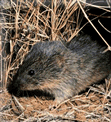
Prairie vole
Order : Rodentia
Suborder : Sciurognathi
Family : Muridae
Subfamily : Arvicolinae
Species : Microtus ochrogaster
The Prairie vole is listed as Least Concern (LR/lc), lowest risk. Does not qualify for a more at risk category. Widespread and abundant taxa are included in this category, on the IUCN Red List of Threatened Species
Some facts about the
Prairie vole
Adult weight : 0.04 kg (0.088 lbs)
Maximum longevity : 5 years
Female maturity :47 days
Gestation : 23 days
Weaning : 20 days
Litter size : 4
Litters per year : 4
Interval between litters : 26 days
Weight at birth : 0.003 kg (0.0066 lbs)
Weight at weaning : 0.017 kg (0.0374 lbs)
Body mass : 0.048 kg (0.1056 lbs)
Temperature : 37.85 °C (100.13 °F)
Facts about the prairie vole
By contrast, the prairie vole(Microtus ochrogaster), is highly social and forms lasting pair bonds after mating.
by Michael Stokes, Department of Biology of Western Kentucky University The prairie vole, Microtus ochrogaster, is the subject of many comparative studies of behavior and neuroendocrinology.
For example, sexually naïve prairie voles are rarely aggressive.
It has been observed that if male and female prairie voles are put together in a cage, they will hang out with one another part of the time, but spend most of their time alone.
NEW MEXICO Microtus ochrogaster is known from New Mexico on the basis of specimens taken by Rowlett (1972) 4 miles south and 2 1/2 miles west of Cimarron, Colfax County, in 1968.
Prairie voles are found throughout South Dakota and are distributed as follows: Natural History
subject, fact, prairie vole, has scientific name Microtus ochrogaster, is a kind of rat, mouse or vole, .
The adult prairie vole is a small rodent with a stocky and stubby body, short tail, and four short legs.
the meadow vole's cousin, the prairie vole (Microtus ochrogaster) is a model of fidelity.
The prairie vole (Microtus ochrogaster) is listed as an animal of Special Concern in Minnesota.
divorce rates, the prairie vole is an inspiration to us all. (Full text)
Prairie voles aren't especially safe at night either, when the night shift of predators, including coyotes and short-eared owls, takes over. (Full text)
Prairie Vole Microtus ochrogasterHabitat: The prairie vole is adapted to the grasslands of interior North America. (Full text)
The Prairie Vole is from the order Rodentia. (Full text)
Hormone of monogamy: the prairie vole and the biology of mating - brain hormone vasopressin associated with monogamy - Cover Story Researchers have determined that monogamy in the male prairie vole is determined by vasopressin. (Full text)
Comments: Prairie voles are a major food source for many of the large, predatory mammals of Kansas. (Full text)
Prairie Vole: The prairie vole is 5 to 7 inches long. (Full text)
background history: mouse-sized rodent that lives in burrows across the American Midwest prairie voles are found in multigenerational family groups with a single breeding pair (Full text)
Prairie voles are short tailed fuzzy mice often known as "meadow mice". (Full text)
More animals beginning with P
